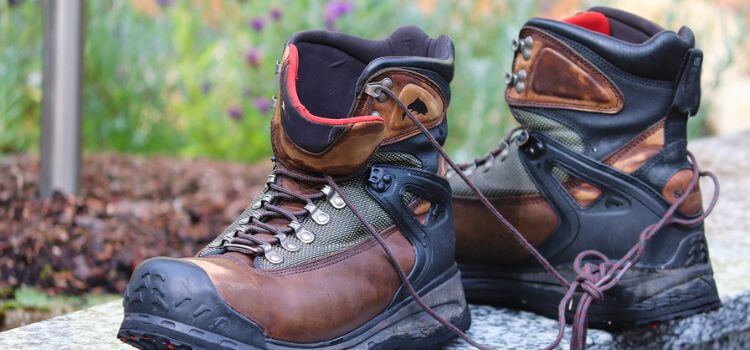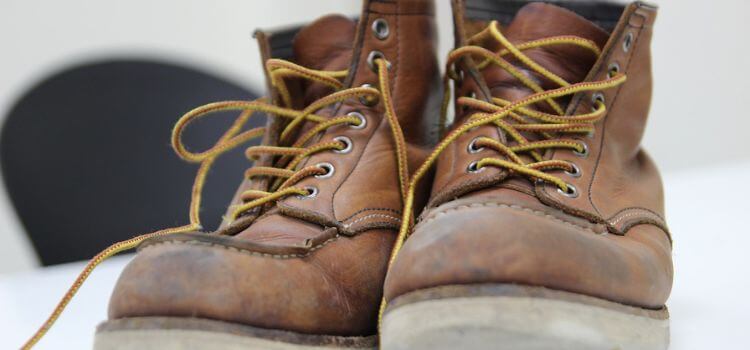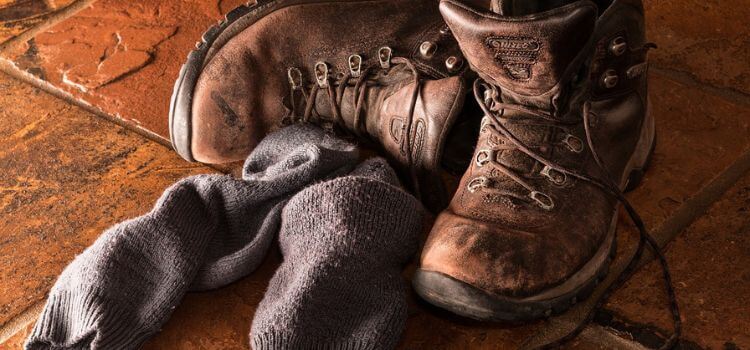Work shoes typically last between 6 to 12 months. Their lifespan depends on daily wear and work conditions.
Selecting the right pair of work shoes is essential, as they’re the foundation of a comfortable and productive workday. A good pair of work shoes protects your feet and can enhance your job performance. But like all items subject to daily wear and tear, they have a limited lifespan.

Workplace conditions such as exposure to chemicals, heavy machinery, and outdoor elements can decrease the longevity of your work shoes. Conversely, light-duty jobs in cleaner environments can extend their usability. It’s important to note the signs of deterioration in work shoes, such as worn-out soles, damaged uppers, or lack of support, and replace them promptly to maintain safety and comfort on the job.
Lifespan Of Work Shoes
Work shoes are vital for safety and comfort on the job. Yet, knowing when they need replacing is key to maintaining their benefits. Different factors affect how long work shoes last. Understanding these can help you get the most out of your footwear.
Typical Wear And Tear
All shoes undergo wear and tear, but work shoes face unique challenges. They might encounter:
- Heavy objects
- Sharp debris
- Extreme temperatures
- Wet conditions
These factors can accelerate the breakdown of your shoes. Often, work shoes last between six to twelve months before needing replacement.
Factors Influencing Durability
The durability of work shoes hinges on several elements:
| Factor | Impact on Durability |
| Material Quality | Higher quality materials often last longer. |
| Work Environment | Rough conditions wear shoes down faster. |
| User Habits | How you use and care for shoes affects longevity. |
| Care and Maintenance | Regular cleaning and care extend shoe life. |
Good habits such as drying wet shoes can prolong their lifespan. Choosing quality over price also plays a part. Know the signs of wear, such as sole thinning or insole discomfort.
Material Matters
How long your work shoes last greatly depends on their material. Different materials handle wear and tear in unique ways. High-quality materials can endure tough conditions, leading to a longer shoe lifespan. Below, we explore the differences between leather and synthetic materials, as well as the impact of sole material on the longevity of work shoes.
Leather Vs. Synthetic
Leather shoes are known for their durability and breathability. With proper care, they can last years. Over time, leather can even mould to the shape of your feet, providing a custom fit. However, they usually come with a higher price tag.
Synthetic materials, on the other hand, are often lighter and more affordable. They can resist water and chemical damage better than leather. However, synthetic shoes may not last as long as their leather counterparts.
| Material | Pros | Cons |
| Leather | Durable, Breathable, Molds to Foot | Higher Cost, Requires Maintenance |
| Synthetic | Lightweight, Water-resistant, Affordable | Less Durable, Can Feel Stiff |
Sole Material Impact
The sole material is a crucial factor in shoe longevity. Rubber soles offer excellent traction and resistance to various surfaces, making them a top choice for heavy-duty jobs. Polyurethane soles are lighter and provide good cushioning, but they may wear down faster than rubber.
- Rubber Soles: Grippy, Durable, Great for Rough Environment
- Polyurethane Soles: Lightweight, Comfortable, Less Resistant to Wear
Choose the right sole based on your work environment and the demands of your job. This will ensure that your work shoes endure the toughest days on the job.
Industry Standards
When it comes to the lifespan of work shoes, “Industry Standards” play a crucial role. Different jobs demand different types of footwear, and some work shoes may wear out quicker than others due to harsh conditions. Industry Standards provide guidelines for durability and functionality, ensuring employees have the right protection for their specific work environment.
Occupational Safety Regulations
Occupational safety bodies like OSHA provide clear regulations. These rules make sure work shoes keep workers safe and last long enough. Companies must follow these standards or face fines. Here are key guidelines:
- Steel toes protect feet in construction.
- Slip-resistant soles are a must in kitchens.
- Electrical hazard footwear is vital for electricians.
Quality And Craftsmanship
Quality speaks volumes about how long work shoes will stand the test of time. Superior materials lead to longer-lasting shoes. Quality stitches and bonds mean fewer rips and separations. Look for these qualities:
| Feature | Benefit |
| Leather Uppers | Durability and protection. |
| Reinforced stitching | Prevents seams from bursting. |
| Anti-slip soles | Decrease accidents on slick floors. |
Craftsmanship matters in work shoes. Expert construction increases comfort and safety. Good shoes support feet and reduce injuries. Remember, better-built shoes may cost more upfront, but they save money over time by lasting longer.
Signs Of Deterioration
Knowing when to replace work shoes is key for comfort and safety. Shoes that are past their prime can lead to discomfort and injury. Let’s spot the signs that a new pair is needed.
Visual Inspection Cues
Take a good look at your shoes. Here’s what might stand out:
- Worn-out soles – Holes or smoothed-down tread patterns show slippage risks.
- Upper damage – Cracks or breaks, especially near flex points, hint at weakness.
- Closed-cell foam – If it doesn’t spring back, support is compromised.
Comfort And Support Loss
When your shoes change on the inside, they may not be protective anymore. Watch out for these inside your shoe:
| Comfort & Support Issue | Why It Matters |
| Insoles flattening | Lack of cushioning can hurt feet. |
| Arch support diminishes | pain in the feet or back, which may start. |
| Fit feels loose | Stability is lost, and tripping risk goes up. |
Proper Care And Maintenance
Proper care and maintenance are key to extending the life of work shoes. Regular attention helps ward off early wear and tear. This guide dives into best practices for keeping work footwear in tip-top shape.

Cleaning Best Practices
Keeping work shoes clean not only makes them look good but also preserves their materials.
- Remove dirt and debris after each use with a soft brush.
- Wipe leather shoes with a damp cloth and mild soap.
- Dry wet shoes naturally away from direct heat to prevent warping.
- Use specifically designed cleaners for suede and nubuck materials.
Storage And Preservation
Proper storage maintains the shape and structure of work shoes.
- Avoid damp or hot areas that can harm shoe materials.
- Use shoe trees to maintain form and absorb moisture.
- Store in a breathable bag or box to prevent dust build-up.
Impact Of Usage Intensity
The lifespan of work shoes can significantly diminish with intense daily use. Understanding how usage intensity affects durability is essential to estimate when to invest in a new pair.
Daily Wear Effects
The more you wear your shoes, the faster they’ll wear out. Daily wear subjects shoes to continuous stress, impacting their overall lifespan. Let’s look at some notable effects:
- Soles thin out due to constant contact with rough surfaces.
- Material fatigue sets in, causing the upper part of the shoe to lose shape.
- Insoles compress over time, reducing foot support and comfort.
- Frequent flexing of the boots can lead to cracks or splits, especially in leather.
Environment-related Wear
Work shoes in harsh surroundings tend to degrade quickly. Key environmental factors include:
| Element | Impact on Shoes |
| Moisture | Speeds up material decay weakens adhesives |
| Heat | Causes material to dry out and crack |
| Chemicals | Erodes soles and can damage protective coatings |
| Abrasive Surfaces | Accelerates outer sole and upper material wear |
Regular exposure to these elements suggests that shoes may need frequent replacement. Shielding your shoes with protective sprays or covers can help combat environmental wear.
When To Replace
Knowing the right time to replace work shoes is vital for comfort and safety. Shoes that are past their prime can lead to discomfort and even injuries. To keep your feet happy and healthy, look out for these signs that indicate it’s time for a new pair.
Assessing Shoe Lifespan
Regular checks on your work shoes can save you discomfort and money. Pay attention to these areas:
- Tread Wear: Worn-out soles can cause slips.
- Upper Damage: Cracks or holes compromise safety.
- Inside Wear: Insoles and linings support the feet.
Make a habit of inspecting your shoes every few months. It helps to pin down if it’s time to replace.
Cost-benefit Analysis Of Replacement
Consider the balance between shoe costs and benefits. A new pair might seem expensive at first glance, but weigh that against these factors:
| Cost Considerations | Benefits of New Shoes |
| Price of the shoes Longevity expectations Maintenance costs | Better foot support Improved safety Increased comfort |
Balance these aspects to determine if it’s time for a replacement. A new pair is an investment in your well-being on the job.
Extending Work Shoe Life
Knowing how to extend the lifespan of work shoes is a clever way to save money and stay comfortable. Regular maintenance and care can double or even triple a shoe’s life expectancy. A few smart habits and minor adjustments can make a significant difference.

Insoles And Liners
Using quality insoles and liners boosts comfort and shoe longevity. They absorb sweat and cushion your feet. This reduces wear on the shoe interior. Replace them regularly to keep shoes fresh and supportive.
- Clean insoles with mild soap and water to remove odours and dirt.
- Air out liners to prevent bacteria growth.
- Choose insoles that match your arch type for added support.
Resoling And Repairs
Durable soles are the foundation of any good work shoe. Once they show signs of wear, consider resoling rather than buying new shoes. Find a reliable cobbler to assess if your shoes are good candidates for resoling. Regular repairs can include:
- Stitching up loose seams.
- Gluing or replacing soles.
- Polishing leather to prevent cracks.
Preventive maintenance will keep your work shoes in action longer. Always inspect them for damage and address issues promptly. This strategy is cost-effective and sustainable.
Frequently Asked Questions For How Long Do Work Shoes Last
How Often Should You Replace Work Sneakers?
Replace work sneakers every 6-12 months or sooner if they show significant wear, ensuring foot safety and comfort on the job.
How Long Should A Good Pair Of Shoes Last?
A good pair of shoes typically lasts for about 8-12 months with regular use. Proper care can extend their lifespan to 2 years or more.
What Is The Average Life Of A Shoe?
The average lifespan of a shoe varies, but it typically ranges between 300 and 500 miles or about 4 to 6 months for regular use.
When Should I Replace My Office Shoes?
Replace office shoes when they show significant wear, such as damaged soles or heels, or when you notice discomfort. Regular assessment every six months can help determine replacement needs.
Conclusion
Determining the lifespan of work shoes hinges on various factors. Regular maintenance and usage impact durability decisively. For optimal performance, choosing quality footwear and caring for it is key. Remember, replacing shoes before they wear out is vital for foot health and comfort.
Stay proactive, and your feet will thank you.
Related posts:
- Can You Play Indoor Soccer With Turf Shoes?
- How To Make Dance Shoes Less Slippery
- Can You Run In Boxing Shoes?
- What Shoes To Wear With Work Pants In Winter
- Are Rudis Wrestling Shoes Good
- How To Remove Water Stains From Leather Shoes
- Can You Wear Socks With Water Shoes
- What Are The Warmest Slippers For Cold Feet
- How To Clean Olukai Shoes
- Are Converse Shoes Non-Slip?: Unveiling the Truth
